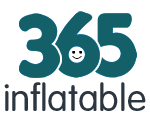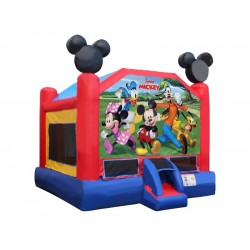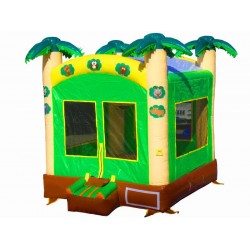Bounce House Setup: Concrete vs. Grass – What’s the Difference?

When setting up a bounce house, the choice of surface can significantly impact the safety, stability, and overall enjoyment of the inflatable. Concrete and grass are two common surfaces for bounce house setup, each offering distinct advantages and challenges. Here’s a comparison of setting up a bounce house on concrete versus grass:
1. Surface Hardness and Impact
Concrete: Concrete is a hard and unforgiving surface. The lack of cushioning increases the risk of injury from falls or collisions. Children may experience more severe injuries if they fall or bump into the bounce house compared to a softer surface.
Grass: Grass provides a softer and more forgiving surface, which can help absorb impacts and reduce the risk of injuries. The natural cushioning of grass makes it a safer option for bounce house activities.
2. Anchoring and Stability
Concrete: Traditional stakes are not suitable for concrete surfaces. Instead, you will need to use weight bags, sandbags, or other heavy anchoring methods to secure the bounce house. Ensuring proper stability is crucial to prevent the inflatable from shifting or tipping.
Grass: Grass allows for the use of traditional stakes to anchor the bounce house securely. The stakes can be driven into the ground to keep the inflatable in place, providing a stable setup.
3. Surface Preparation and Maintenance
Concrete: Concrete surfaces need to be clean and free of debris or sharp objects that could damage the bounce house. Regular inspection is necessary to ensure that the surface does not have any hazards that could cause punctures or other issues.
Grass: Grass surfaces should be level and free of large rocks or sticks that could potentially damage the inflatable. However, grass is generally easier to maintain and can naturally handle the wear and tear of bounce house use.
4. Comfort and Enjoyment
Concrete: The hard surface of concrete does not offer the same level of comfort and bounce experience as grass. The bounce house may feel less bouncy and enjoyable, and the hard surface can make play less comfortable for children.
Grass: Grass provides a more comfortable and enjoyable bounce experience. The natural cushioning contributes to a more pleasant play environment, enhancing the overall enjoyment for children.
5. Weather Considerations
Concrete: Concrete is less affected by weather conditions, making it a more stable surface during wet or dry conditions. However, it can become very hot in direct sunlight, so be cautious about overheating.
Grass: Grass can be impacted by weather conditions such as rain, which can make the surface muddy and slippery. Proper drainage and monitoring of weather conditions are important to ensure a safe setup on grass.
6. Setup and Takedown
Concrete: Setting up and taking down a bounce house on concrete requires additional equipment for anchoring and may involve more effort to ensure stability. The setup process might be more complex compared to grass.
Grass: Grass surfaces generally make for an easier setup and takedown process. Traditional stakes are simple to use, and the surface naturally accommodates the bounce house, making the process more straightforward.
7. Safety and Supervision
Concrete: Enhanced supervision is needed when using a bounce house on concrete due to the increased risk of injury. Extra precautions, such as using protective mats, can help mitigate risks.
Grass: While grass provides a safer surface, supervision is still important to ensure children follow safety rules and play safely. The softer surface naturally reduces some risks, but active monitoring is essential.
Conclusion
Choosing between concrete and grass for setting up a bounce house involves weighing the pros and cons of each surface. Concrete offers stability and less susceptibility to weather conditions but requires additional safety measures and equipment. Grass provides a softer and more forgiving play environment, making it a generally safer option for bounce house activities. Consider your specific needs and the safety of the children when deciding on the best surface for your bounce house setup.



